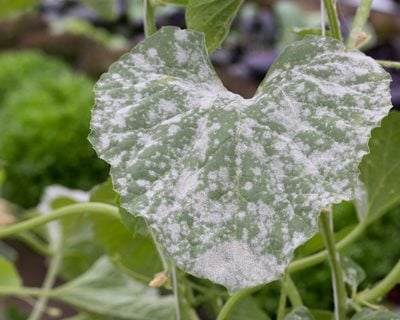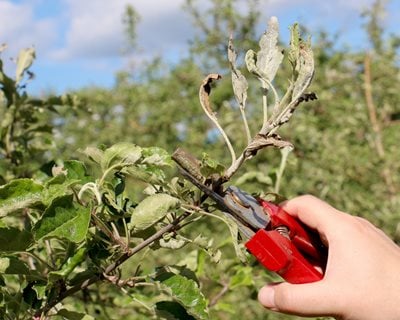How to Get Rid of Powdery Mildew
Learn ways to treat and prevent powdery mildew
Photo by AJ Cespedes / Shutterstock.com
Powdery mildew is a common fungus that affects a wide variety of plants. It is easily identified and appears as light grey or white powdery spots usually found on infected leaves, but can also be found underneath, or on stems, flowers, fruit or vegetables. The spots spread and will eventually cover most of the leaves on the plant, with new plant growth being most susceptible.
Powdery mildew thrives in warm, dry climates; however, it also needs fairly high humidity — like the warm days and cool nights in late spring to early summer. Not enough sunlight and poor air circulation also contribute to conditions that encourage powdery mildew.
Although rarely fatal, if left unchecked it can eventually cause serious harm to your plants by robbing it of water and nutrients. Most infections cause minor damage such as leaves turning yellow or becoming withered or distorted, but plants can also become weak, bloom less, and grow slower.
POWDERY MILDEW PREVENTION
Here are some things you can do to control powdery mildew before it occurs:
- Thin out existing susceptible plants to improve airflow within the plant.
- Maintain adequate spacing between plants and keep them far enough away from walls and fences to ensure good air circulation and help reduce relative humidity.
- Locate plants in proper sunlight according to their needs.
- Maintain healthy plants by removing dead or diseased foliage.
- Disinfect pruners or shears after use on infected plants. (See Tool Care & Maintenance)
- Because new growth tends to be more susceptible, be careful to not over-fertilize and cause a rush of new foliage.
- Treat regularly with an organic fungicide that contains sulfur as the active ingredient. This can be used as a preventative measure as well as treatment for existing powdery mildew.
- When shopping for plants, choose varieties with increased resistance to powdery mildew.
POWDERY MILDEW TREATMENT
Although most products on the market are targeted more toward the prevention of powdery mildew, there are many home remedies to treat an existing infection. Spray mixtures will only kill what they come in contact with, so be sure to coat all affected areas thoroughly. It may take multiple applications for complete treatment. Apply once a week for three to four weeks, then wait to see results. Reapply as needed.

Pruning apple leaves damaged by powdery mildew. Photo by: agrofruti / Shutterstock.com
- Baking soda solution: Mix 1 tablespoon baking soda and ½ teaspoon liquid soap such as Castile soap (not detergent) in 1 gallon of water. Spray liberally, getting top and bottom leaf surfaces and any affected areas. This method may work better as a preventative measure, although it does have some effect on existing powdery mildew as well.
- Potassium bicarbonate: Mix 1 tablespoon potassium bicarbonate and ½ teaspoon liquid soap (not detergent) in 1 gallon of water. Spray liberally to all affected areas. This mixture may work better than baking soda as a treatment for existing infections.
- Milk: Mix 1 part milk to 2 to 3 parts water and spray liberally. While the science behind this solution isn’t fully understood, it seems to work rather well, especially on zucchini, melons and cucumbers. It is believed that naturally-occurring compounds in the milk not only combat the disease, but also boost the plant’s immune system.
- Neem oil: By itself, neem oil has mixed reviews on its effectiveness to treat powdery mildew, but it can be added to the above mixtures for an extra boost. (Read more on how to use neem oil.)
- Powdery mildew fungicide: Use sulfur-containing organic fungicides as both preventive and treatment for existing infections.
- Trim or prune: Remove the affected leaves, stems, buds, fruit or vegetables from the plant and discard. Some perennials can be cut down to the ground and new growth will emerge. Do not compost any damaged or diseased foliage as the spores can spread and persist in the composted material. Disinfect pruners and all tools after using on infected plants.
HOW DOES POWDERY MILDEW SPREAD?
Mildew spores are spread by the wind in warm, dry weather, but don’t spread well when conditions are rainy and cool. Powdery mildew strains are specialized to certain groups of plants and generally don’t spread to other plant families. Spores can survive over winter in leaf piles and on plants, so it’s important to discard and not compost any plant debris dropped from infected plants to prevent spreading or allow it to resurface the following spring.
SUSCEPTIBLE PLANTS
Essentially, there aren’t any plants that are completely immune to some form of powdery mildew, including vegetables, roses, trees and shrubs.
There are some plants that are more susceptible to powdery mildew than others, such as:
- Begonias
- Sunflowers
- Chrysanthemums
- Dahlias
- Roses
- Zinnias
- Melons
- Zucchini
- Squash
- Lettuce
- Cucumbers
- Potatoes
- Parsley
- Pumpkins
- Grapes
- Peppers
- Tomatoes
If you have recurring problems with powdery mildew, look for varieties that are noted to have improved disease resistance — this should be noted on the plant tag.
How to treat powdery mildew on roses? Remove and discard any affected leaves, as well as any that have dropped to the ground, and treat the rest of the plant preventatively. If you see powdery mildew on buds, clip and discard them as well. Thoroughly clean and disinfect any cutting tools that were used in the process. Apply one of the treatments above, such as a fungicide, baking soda, potassium bicarbonate or milk mixture once a week for 3 to 4 weeks and wait to see the results. Prevent further outbreaks with regular applications every couple of weeks or follow directions on product labels. Ultimately, results will be much better if the infection is caught at the first signs and treated quickly.
Try these roses that boast increased resistance to powdery mildew:
What is the best treatment for powdery mildew on squash? The milk mixture mentioned above seems to have better results that the other methods. Again, the science behind why it works is still being discovered, but it does appear to not only prevent a powdery mildew infection, but also boost the plant’s immunity.
RELATED:
Black Spot on Roses
Eco-Friendly Pest Control
How to Fertilize Roses



